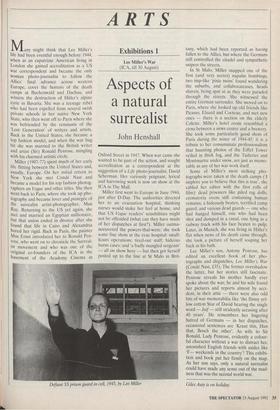ARTS
Exhibitions 1
Lee Miller's War (ICA, till 30 August)
Aspects of a natural surrealist
John Henshall
Many might think that Lee Miller's life had been eventful enough before 1944, when as an expatriate American living in London she gained accreditation as a US war correspondent and became the only woman photo-journalist to follow the Allies' final advance across western Europe, cover the horrors of the death camps at Buchenwald and Dachau, and witness the destruction of Hitler's alpine eyrie in Bavaria. She was a teenage rebel who had been expelled from several swish private schools in her native New York State, who then went off to Paris where she was befriended by the remnants of the 'Lost Generation' of writers and artists. Back in the United States, she became a top fashion model, and when the war bug bit she was married to the British writer and artist (Sir) Ronald Penrose, mingling with his charmed artistic circle.
Miller (1907-77) spent much of her early life flitting between the United States and, usually, Europe. On her initial return to New York she met Conde Nast and became a model for his top fashion photog- raphers on Vogue and other titles. She then went back to Paris, where she took up pho- tography and became lover and protegee of the surrealist artist-photographer, Man Ray. Returning to the US yet again, she met and married an Egyptian millionaire, but that union ended in divorce after she found that life in Cairo and Alexandria bored her rigid. Back in Paris, the painter Max Ernst introduced her, to Ronald Pen- rose, who went on to chronicle the Surreal- ist movement and who was one of the original co-founders of the ICA in the basement of the Academy Cinema in Oxford Street in 1947. When war came she wanted to be part of the action, and sought accreditation as a correspondent at the suggestion of a Life photo-journalist, David Scherman. Her variously poignant, lyrical and harrowing work is now on show at the ICA in The Mall.
Miller first went to Europe in June 1944, just after D-Day. The authorities directed her to an evacuation hospital, thinking nurses would make her feel at home, and that US Vogue readers' sensibilities might not be offended (what can they have made of her dispatches at first?). Miller outma- noeuvered the powers-that-were; she took some fine shots at the evac hospital: small- hours operations; tired-out staff; hideous burns cases; and 'a badly mangled sergeant' — all on show here — but then got herself posted up to the line at St Malo in Brit- Defiant SS prison guard in cell, 1945, by Lee Miller tany, which had been reported as having fallen to the Allies, but where the Germans still controlled the citadel and sympathetic snipers the streets.
In St Malo, Miller snapped one of the first (and very secret) napalm bombings, two imp-like 'pixie twins' found wandering the suburbs, and collaborateuses, heads shaven, being spat at as they were paraded through the streets. She witnessed the entire German surrender. She moved on to Paris, where she looked up old friends like Picasso, Eluard and Cocteau, and met new ones — there is a section on the elderly Colette. Miller's hotel room resembled a cross between a news centre and a brewery. She took some particularly good shots of Paris during the winer of 1944-45: it is a tribute to her consummate professionalism that haunting photos of the Eiffel Tower veiled in thick fog, and the Tuileries and Montmartre under snow, are just as memo- rable as any of her war work itself.
Some of Miller's most striking pho- tographs were taken at the death camps el implore you to believe that this is true', she cabled her editor with the first rolls of film): dead prisoners like piled rag dolls; crematoria ovens still containing human remains; a hideously beaten, terrified camp guard; and various dead guards — one who had hanged himself, one who had been shot and dumped in a canal, one lying in a railway truck with his face beaten to pulp. Later, in Munich, she was living in Hitler's flat when news of his death came through; she took a picture of herself soaping her back in his bath.
Lee Miller's son, Antony Penrose, has edited an excellent book of her pho- tographs and dispatches, Lee Miller's War (Conde Nast, f35). The former overshadow the latter, but her stories still fascinate. Penrose reveals his mother hardly ever spoke about the war; he and his wife found her pictures and reports almost by acci- dent, in their attic — there were also odd bits of war memorabilia like 'the flimsy yel- low cotton Star of David bearing the single word —Juif — still stridently accusing after 40 years'. He remembers her lingering hatred of Germans — in her dispatches, occasional sentences are 'Kraut this, Hun that, Bosch the other'. As wife to Sir Ronald, Lady Penrose, evidently a colour- ful character without a war to distract her, astonished English friends with asides like 'F— weekends in the country'! This exhibi- tion and book put her firmly on the map. As her son says, only a natural surrealist could have made any sense out of the mad- ness that was the second world war.
Giles Auty is on holiday.


















































 Previous page
Previous page